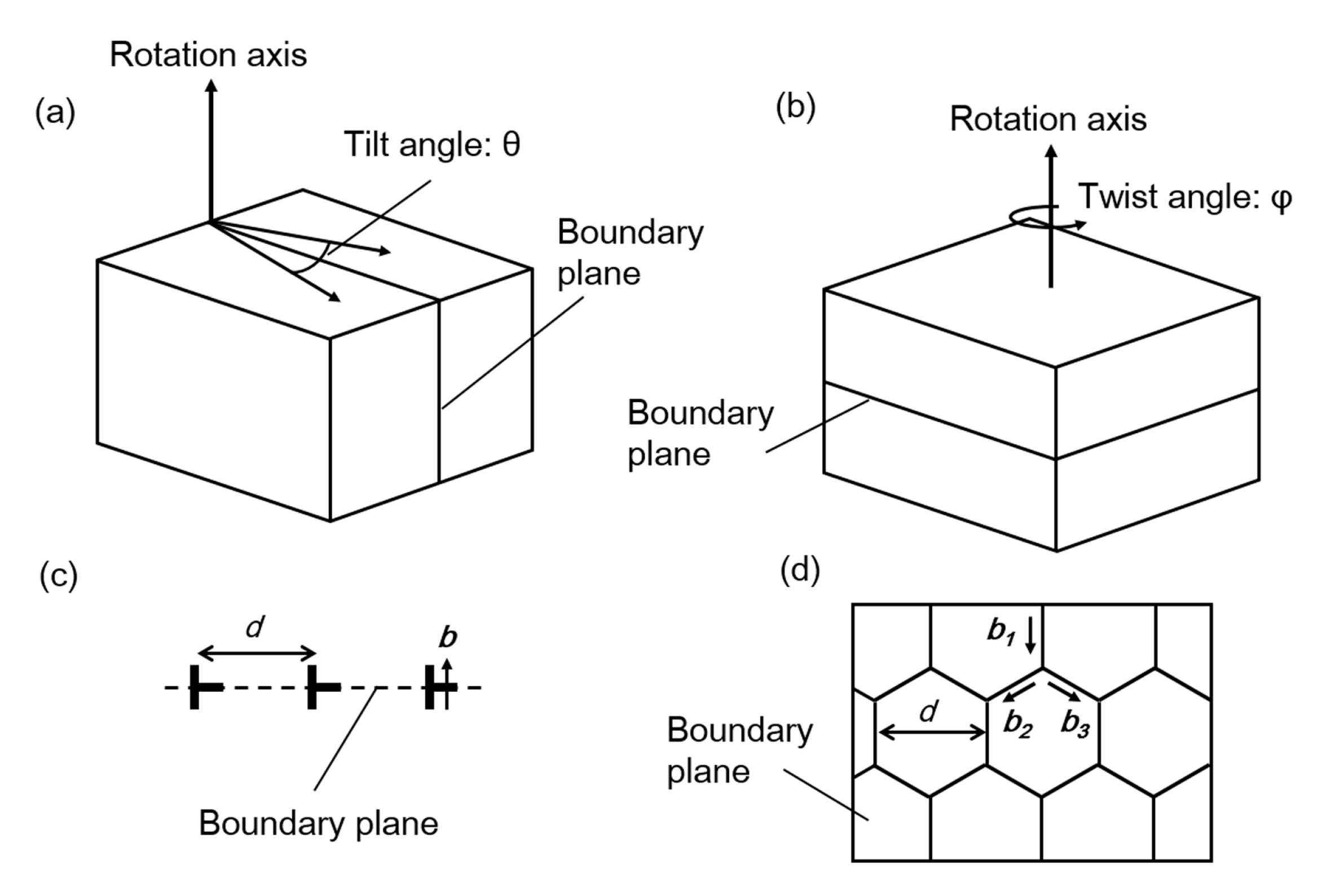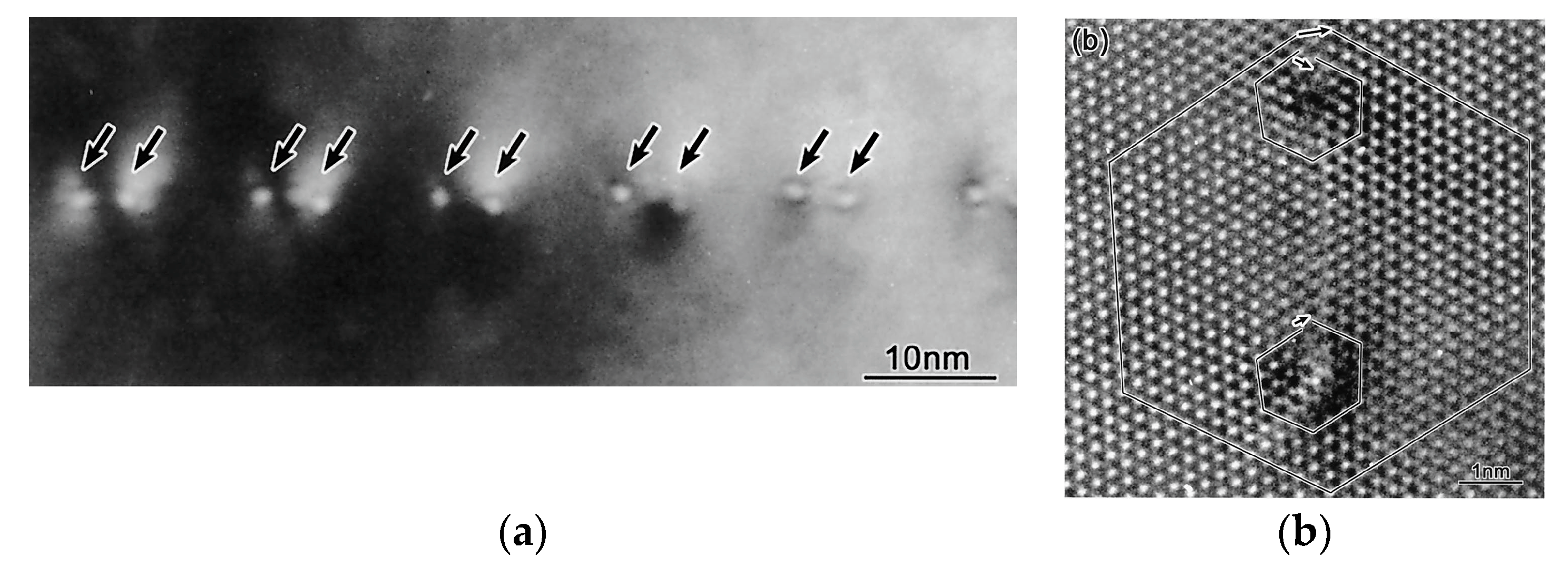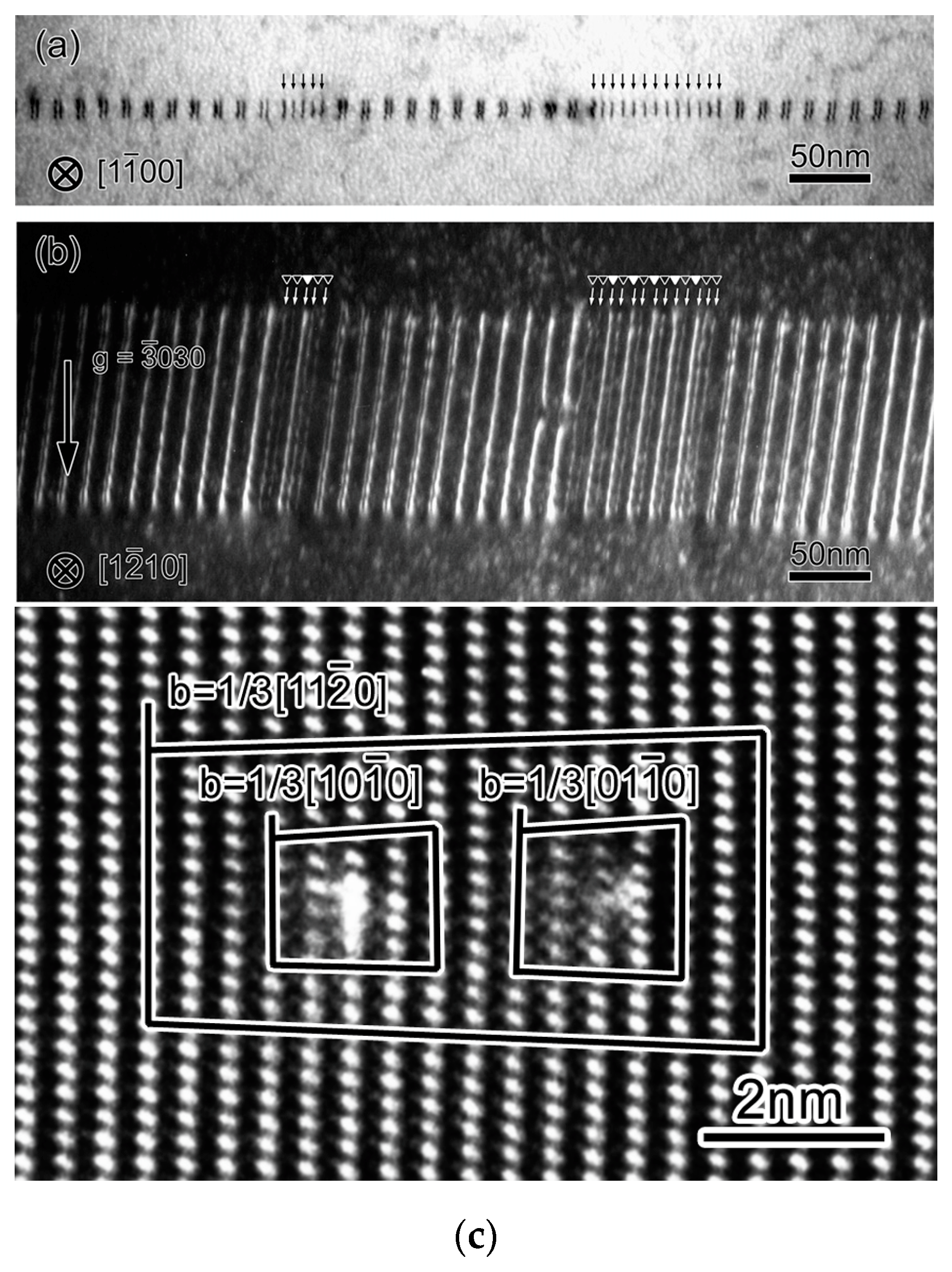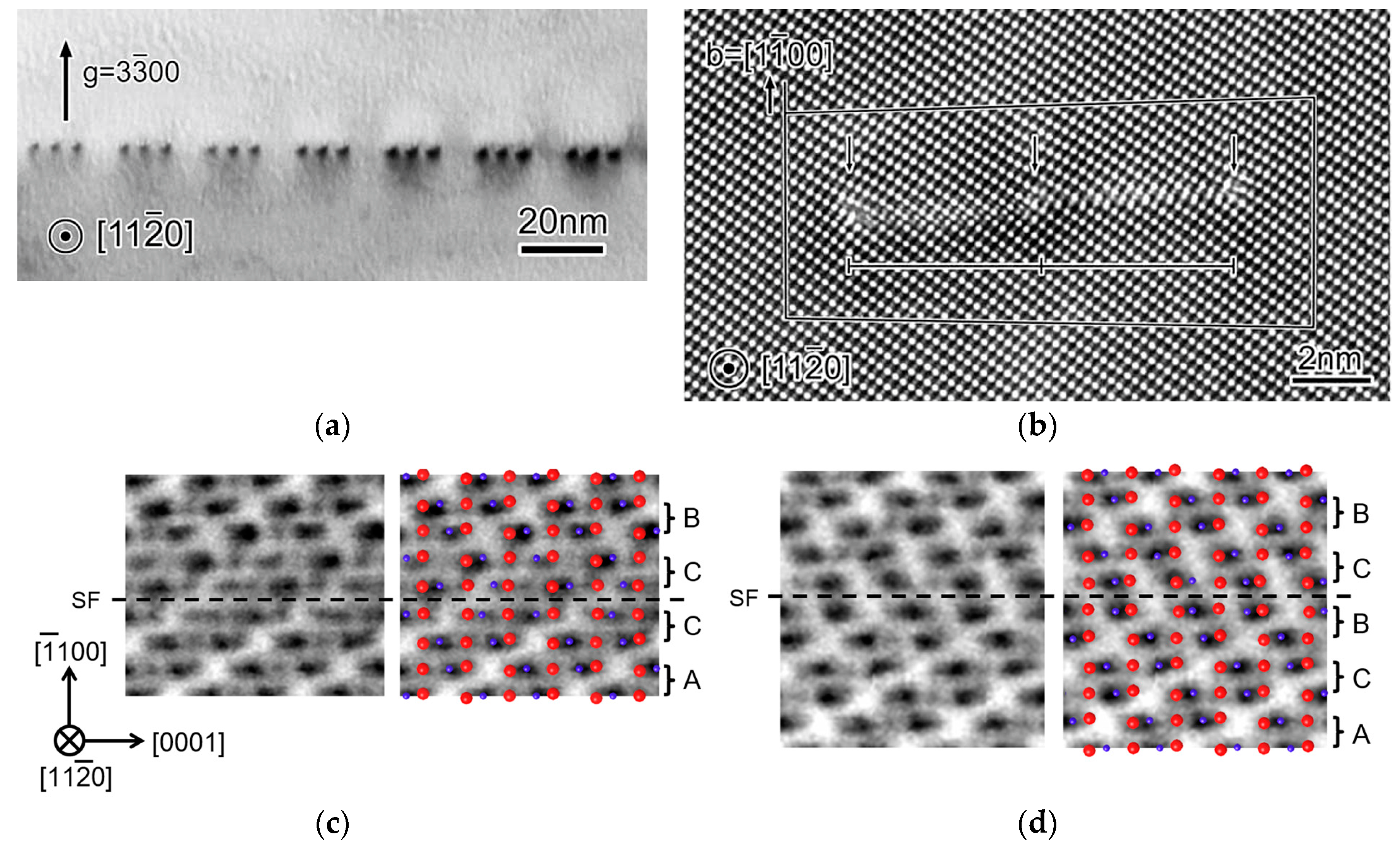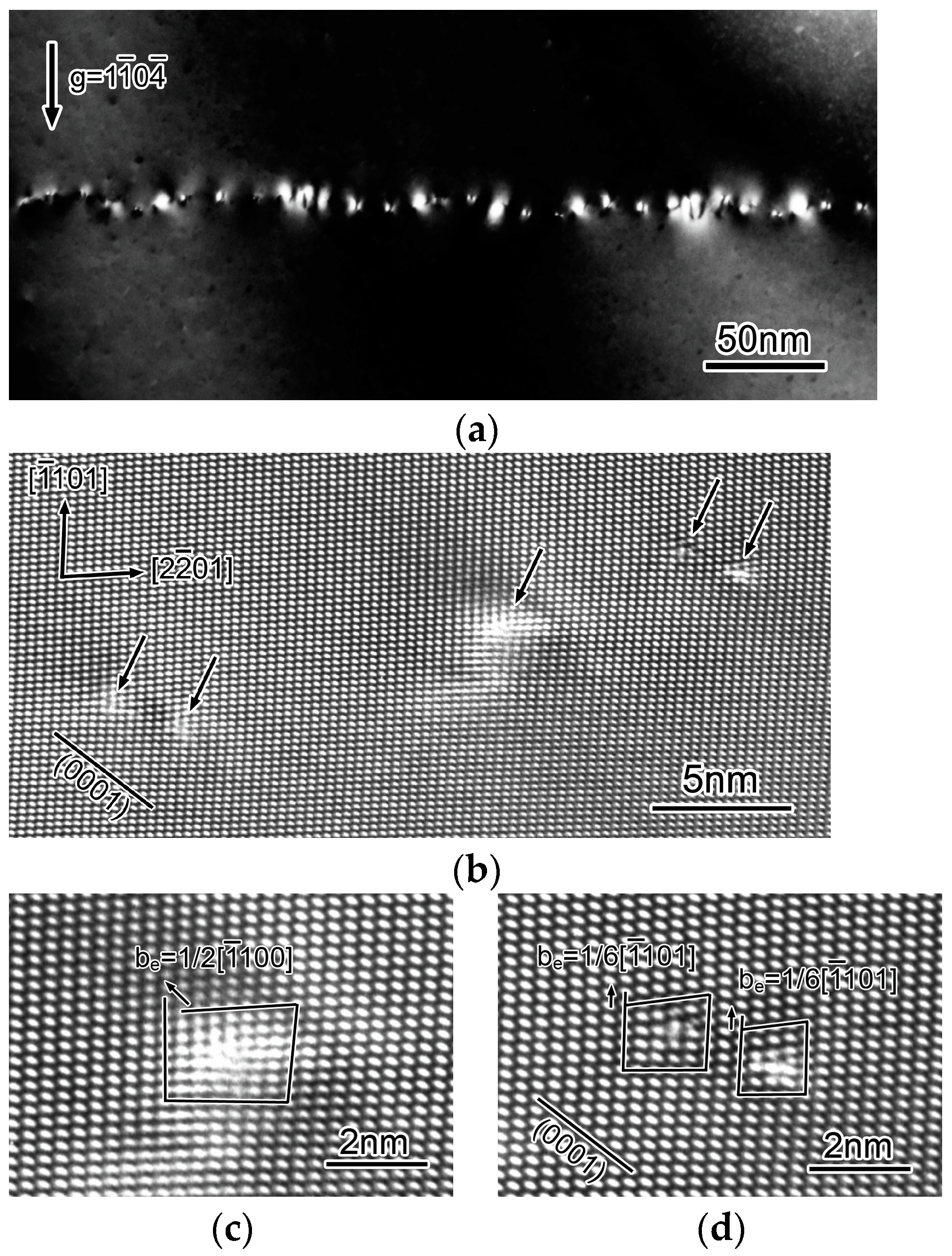3.1. Low-Angle Tilt Grain Boundary
Figure 2a shows a TEM image of the
2° low-angle tilt grain boundary. Pair contrasts are periodically arrayed with the interval of about 13.2 nm, suggesting that each dislocation is dissociated into two partial dislocations. The Burgers vector of the dislocation pairs should be
b =
in total because the translation vector of
is perpendicular to the
grain boundary plane. Substituting
d = 13.2 nm and |
b| = |
| = 0.476 nm into Equation (1), the misorientation angle θ is estimated to be 2.1°, which agrees with the designed angle of the present grain boundary.
A HRTEM image of a dislocation pair in the grain boundary is shown in
Figure 2b. The two dislocation cores corresponding to partial dislocations are observed. These partial dislocations are separated along the
plane, suggesting that a stacking fault on the
plane is formed between the partial dislocations. The plane of the stacking fault does not coincide with the slip plane of the perfect dislocation. Accordingly, the partial dislocations were separated by the self-climb mechanisms. This type of dissociation is called the climb dissociation. The large Burgers circuit shows that this dislocation pair has the Burgers vector of
, and the small Burgers circuits show that the upper and the lower partial dislocations have the Burgers vectors of
and
, respectively. This dissociation reaction is represented as follows:
The
grain boundaries with the tilt angle of 6° and 8° were also found to consist of the same type of partial-dislocation pairs [
21]. It is known that the slip dislocation associated with the
basal slip (the so-called basal dislocation) has the Burgers vector of
, and the
basal edge dislocation also dissociates into two partial dislocations following the reaction of Equation (2) [
4,
6,
10]. Note that
edge dislocation in the
tilt grain boundary has the line direction of
, whereas the
basal edge dislocation has the line direction of
. Therefore, they are not equivalent to each other.
The
stacking faults generated by the
or
partial dislocations are known to be structurally equivalent [
5,
11]; that is, there is only one type for the {11
0} stacking fault. The formation energy of a stacking fault (stacking fault energy)
γSF formed between a partial-dislocation pair can be estimated by calculating the repulsive force acting between the partial dislocations based on an elastic theory, which is the so-called Peach–Kohler equation [
2]. For a partial-dislocation pair in a low-angle boundary, contributions from other dislocations also need to take into account the force calculations, and a detailed derivation is given elsewhere [
21,
33]. For the present case, the repulsive force
f (=
γSF) is represented as follows:
where
μ is the shear modulus (~150 GPa [
34]),
ν is Poisson’s ratio (~0.24 [
35]),
bp is the magnitude of the Burgers vector of partial dislocations,
= 0.275 nm, and
α is
d1/
d (
d1: the spacing of a partial dislocation pair, or the width of the stacking fault). Using the averaged distances measured from our experiment,
d = 13.2 nm and
d1 = 4.6 nm, the stacking fault energy was estimated to be 0.32 Jm
−2. This value agrees well with an experimental value calculated from an isolated partial-dislocation pair in a deformed crystal, 0.28 Jm
−2 [
11]. In addition, a couple of theoretical studies have been carried out to examine the {11
0} stacking fault [
36,
37], and one using first-principles calculations within the generalized gradient approximation proposed a similar value of 0.35 Jm
−2 [
37].
From Equations (1) and (3), the relationship between d1 and θ is given. Since the stacking fault energy does not depend on the tilt angle, d1 can be obtained as a function of θ. This indicates that the configuration of partial dislocations dissociated by climb in a low-angle boundary can be predicted by the stacking fault energy corresponding to the grain boundary plane in addition to the orientation relationship.
3.2. Low-Angle Tilt Grain Boundary
Figure 3a shows a TEM image of the
low-angle 2° tilt grain boundary. It is seen that dislocations are periodically arrayed along the grain boundary. The dislocation structure is divided into two groups, pairs of dislocations and groups of odd-numbered dislocations.
Figure 3b shows a dark-field TEM image taken at the same region in
Figure 3a using the reflection of
g =
, where the
grain boundary plane is inclined by about 30° from the observation direction. The dislocations are clearly seen as line contrasts.
Figure 3c shows an HRTEM image of a dislocation pair. The dislocation is dissociated into two partial dislocations on the
plane. The large Burgers circuit shows that the dislocation pair has the Burgers vector of
in total. The small Burgers circuits show that each partial dislocation has an edge component of
. This component corresponds to the
projection of the vectors of
and
. Therefore, it is considered that the observed structure corresponds to the dissociation of the
edge dislocation into the
and
mixed partial dislocations according to the reaction of Equation (2). The
low-angle 10° tilt grain boundary was also investigated and found to consist of the same type of partial-dislocation pairs [
25]. The
edge dislocation formed in the
tilt grain boundary has the dislocation line direction of
, and thus this dislocation structure is considered to be equivalent to that of the
basal edge dislocation associated with the
basal slip [
10].
The distances between dislocations
d and
d1 were measured to be 15 nm and 3.6 nm. Using Equation (3) (where the coefficient attributes
), the formation energy of the
stacking fault was estimated to be 0.30 Jm
−2 [
24]. This value is consistent with that estimated using the
low-angle tilt grain boundary, as discussed in
Section 3.1.
For the imaging condition of
g =
in
Figure 3b, the partial dislocations with
b1 =
and with
b2 =
have strong and weak contrasts, respectively. As seen in
Figure 3b, the partial-dislocation pairs (
b1–
b2 pairs) are imaged as the strong and weak line contrasts. From the contrast features, the configurations of the group of five and thirteen partials are found to be
b1b1b2b1b1 and
b1b1b2b1b2b1b2b1b2b1b2b1b1. The edge components of the partial dislocations with
b1 and
b2 are both
, whereas their screw components are
and
, respectively. Therefore, it is found that the 5-partial structure has an edge component of
and a screw component of
in total, and the 13-partial structure has an edge component of
and a screw component of
. Note that both of the structures have the same screw component. This suggests that the odd numbered dislocation structures are generated by the twist component of the grain boundary. The averaged interval of the odd-numbered dislocation structures was about 230 nm. Substituting
d = 230 nm and |
b| =
= 0.407 nm into Equation (1), the twist angle is estimated to be 0.10°. This value is possible considering the accuracy of the bicrystal fabrication processes.
The odd-numbered dislocation structures can be written by the general expression as:
where
n is an integer. The odd-numbered dislocation structures with the
n-value of 0–7 (corresponding to 3 to 17-partial structures) have been found so far [
22,
26]. The characteristic dislocation configuration in the present grain boundary is explained as follows. An additional twist component to the
low-angle tilt grain boundary generates the
mixed dislocations into the
edge dislocation array. The
dislocation dissociates into three
partial dislocations with the
stacking faults, which are equivalent to that formed between the partial-dislocation pair associated with the
dislocation. As a result, the partial dislocations generated from the
and
dislocations are combined into the odd-numbered partial structures. In addition, there is a variation of the
n-values for the odd-numbered partial structures. This would be because the competition between the strain energy and the excess energy of stacking faults. The net screw component of the partial structures with smaller
n-values is more localized than that with larger
n values, namely that the strain energy decreases with the
n-value. In contrast, the area of stacking fault increases with the
n-value.
3.3. Low-Angle Tilt Grain Boundary
Figure 4a shows a TEM image of the
2° tilt grain boundary. Dislocation triplets are arrayed along the grain boundary, suggesting that the dislocations dissociated into three partial dislocations with
stacking faults. An HRTEM image of a dislocation triplet is shown in
Figure 4b. The three partial dislocations connected with the two stacking faults are clearly observed. The Burgers circuit shows that this dislocation triplet has the Burgers vector of
in total. Therefore, this dissociation reaction is written as:
This dissociation reaction is known to occur for the
slip dislocation associated with the
prism-plane slip [
5].
The two stacking faults on the
plane are formed between three partial dislocations. The stacking sequence of the
plane is represented as …ABCABC…. Thus, the stacking faults generated by the fault vector of
have structural variations: …ABC/B/ABC…, …ABC/C/ABC…, and …ABC//BCA…, where the position of stacking disorder is indicated by ‘//’. These stacking faults are called interstitial fault type-I (I
1), interstitial fault type-II (I
2), and vacancy fault (V), respectively [
8,
27]. Due to the geometric constraint, the combination of the stacking faults formed between the
triplet is known to be either of I
1-V or I
2-V [
8,
27]. To identify the structure of the stacking faults formed between the partial dislocations, we observed the stacking faults by atomic-resolution STEM.
Figure 4c,d show annular bright-field (ABF) STEM images of the stacking faults, corresponding to the left and the right ones in
Figure 4b, respectively. ABF STEM is capable of visualizing atomic columns and even light elements [
38,
39]. In these images, strong dark contrasts correspond to aluminum columns and weak dark contrasts to oxygen columns, as shown in the atomic structure model in the figure. The stacking sequences of the stacking faults can be directly interpreted as …ABC/C/ABC… (I
2) for the left stacking fault and …ABC//BCAB…: (V) for the right stacking fault.
Their stacking fault energies can be estimated by the similar way as discussed in
Section 3.1. For the present case, the equations become the following forms:
where
α1 is
d1/
d (
d1: the width of staking fault
I2) and
α2 is
d2/
d (
d2: the width of staking fault
V). The experimental distances of
d,
d1 and
d2 were measured to be 22 nm, 4.7–5.1 nm, and 5.5–5.9 nm, respectively. Using these values, the stacking fault energies were estimated to be I
2:
γ = 0.41–0.46 Jm
−2 and
V:
γ = 0.33–0.37 Jm
−2. Theoretical calculations suggested that the stacking fault energies of I
1, I
2, and
V are 0.62–0.63 Jm
−2, 0.46 Jm
−2, and 0.41 Jm
−2, respectively [
27,
37]. These results agree well with the experimental results.
3.4. Low-Angle Tilt Grain Boundary [30]
Figure 5a shows an HRTEM image of the
2° low-angle tilt grain boundary. Five dislocation structures are observed and each dislocation structure appears to consist of two partial dislocations with a stacking fault on the
plane. From the Burgers circuits, the edge component of these dislocations is either of
,
, or
. These components do not correspond to a translation vector, and thus these dislocations should be a mixed dislocation with a screw component along the
direction. The screw components can be uniquely determined so as to match a possible translation vector as follows:
The sum of these three vectors is , and their screw components are cancelled out in total. Since the vector is the translation vector perpendicular to the boundary plane, it can be said that the tilt component of the grain boundary is effectively accommodated by groups of these three equivalent dislocations of , , and . This characteristic dislocation configuration is reasonable in terms of dislocation self-energy, which is proportional to the square of Burgers vector. The magnitude of the vector is 1.30 nm and that of vector is 0.513 nm, leading the relationship of |b[0001]|2 > 3 × |b1/3<−1101>|2. Therefore, the triplet of dislocation is considered to be energetically favorable than the single dislocation.
Figure 5b shows an ABF STEM image of the
dislocation. The zigzag contrasts along the
direction correspond to the configurations of oxygen and aluminum columns as illustrated in the atomic structure at the right. It is clearly seen that the dislocation is dissociated into two partial dislocations with the
stacking fault. The Burgers circuits drawn around the partial dislocations indicate that the left and right ones have an edge component of
and
, respectively. Their screw components, which are necessary to determine the dissociation reaction, are not given by the STEM observations. To identify the Burgers vector of the partial dislocations, instead, we analyzed the fault vector of the stacking fault.
An ABF STEM image of the
stacking fault formed between the partial dislocations is shown in
Figure 5c. The position of the stacking fault is indicated by the dashed line. As shown in the figure, the stacking sequence along the
direction on the
projection is …1 2A 3 2B 1 2C 3//1A 2 1B 3 1C…, where the single numbers refer to oxygen layers and the numbers with a letter to aluminum layers. Theoretical calculations revealed that there is the displacement of
or
across the
stacking fault shown in
Figure 5c [
30], namely that the partial dislocations have a screw component of
or
. Here, the screw components of the partial dislocations are uniquely determined to be
because the partial-dislocation pair has the screw component of
in total (see Equation (10)). As a result, the Burgers vectors for the two partial dislocations are identified to be
and
. Consequently, the dissociation reaction of the
mixed dislocations is represented by the following equation:
The
dislocation is known to be associated with the
pyramidal slip (The
and
planes are also possible.) [
7]. The dissociation reaction of the
slip dislocation has not been reported.
The formation energy of the
stacking fault can be calculated by a theoretical equation similar to Equation (3). In the present case, however, it should be too complicated to derive such theoretical equations because the grain boundary consists of six kinds of partial dislocations. Instead, the
stacking fault energy was numerically calculated using the actual dislocation configurations identified from our experimental observations, and the calculated value was 0.58 Jm
−2 [
30]. In addition, first-principles calculations suggested the stacking fault energy to be 0.72 Jm
−2 [
30].
3.5. Low-Angle Tilt Grain Boundary
Figure 6a shows a dark-field TEM image of the
low-angle 2° tilt grain boundary taken using
g =
. The grain boundary appears to be wavy, and relatively broad contrasts and pair contrasts are observed, suggesting that the grain boundary consists of multiple kinds of dislocation structures.
Figure 6b shows an HRTEM image of the grain boundary. A single dislocation and two dislocation pairs are observed, as indicated by the arrows.
Figure 6c shows an enlarged image of one of the single dislocations. The single dislocation has an edge component of
. Since this component does not correspond to a translation vector, the single dislocation should have a screw component along the
direction. The screw component is considered to be
(or
), which makes the smallest translation vector of
(or
). Therefore, the single dislocation should be the
mixed dislocation. An HRTEM image of a dislocation pair dislocation is shown in
Figure 6d. This dislocation structure consists of two partial dislocations with a stacking fault on the
plane. The Burgers circuits show that the total edge component is
, and each partial dislocation has an edge component of
. Since
vector corresponds to a translation vector, this dislocation structure is considered to be the
edge dislocation.
It was found that the low-angle tilt grain boundary consists of not only one kind of dislocation structure. This is because there is no translation vector perpendicular to the grain boundary plane. The vector corresponding to the dislocation pair is at an angle of 84.16° to the grain boundary plane. This vector introduces a component parallel to the grain boundary of = 0.052 nm (along the direction) in addition to the component normal to the grain boundary. This additional component should be cancelled out in total over the grain boundary by another vector. The vector corresponding to the edge component of the dislocation is at an angle of 141.76° to the plane. This vector has a component along the direction of = −0.32 nm, which can compensate the additional components due to the vector. Therefore, it is considered that the dislocation pairs and the dislocations are mixed in the grain boundary so as to cancel out a component along the direction. The ideal ratio of the numers of the dislocation pairs to the dislocations is estimated to be 0.32/0.052 = ~6.2.
Here, we further discuss the structure of the
dislocation pair. Theoretical calculations revealed that the
stacking fault formed between the partial dislocations has a displacement of
and its structure is identical to the
stacking fault shown in
Figure 5c [
32]. The dislocation pair has no screw component in total, and thus the Burgers vectors of the partial dislocations are
and
. Consequently, it is found that the dissociation reaction of the
edge dislocation also corresponds to Equation (11).
3.6. Low-Angle Twist Grain Boundary
A low-angle twist grain boundary was fabricated by joining two pieces of alumina substrate. The twist angle around the axis was expected to be as much as the cutting accuracy of the substrate sides (<~0.1°). Two TEM samples were prepared: ones for plan-view and for edge-on observations.
Figure 7a shows a plan-view TEM image of the
low-angle twist grain boundary. The observation direction is along the
zone axis. A hexagonal dislocation network is formed on the grain boundary. Since these dislocations are parallel to either of the three equivalent directions of
, they should correspond to the
screw dislocations. The interval of the equivalent dislocations is about 60 nm. Using Equation (1), the twist angle of this grain boundary is estimated to be 0.45°.
An HRTEM image of a
screw dislocation in the grain boundary viewed end-on is shown in
Figure 7b. The image contrasts are slightly disordered over a few atomic columns, corresponding to the dislocation core region. The circuit drawn around the dislocation core is closed, indicating that this dislocation is a pure screw dislocation. From the image contrasts, the dislocation core is localized within 1 nm or less, and thus the
screw dislocation is not dissociated, in contrast to the
edge dislocation, as discussed in
Section 3.2. The
screw dislocation in the present grain boundary corresponds to the
basal screw dislocation associated with the
basal slip. The basal screw dislocation is likely to have the perfect type core structure, although its core structure has not been reported. If this is the case, it is considered that the basal screw dislocation slips easily in comparison with the basal edge dislocation. This is because the
stacking fault generated by the dissociation of the basal edge dislocation is not on the
slip plane and does not move without atomic diffusion.
